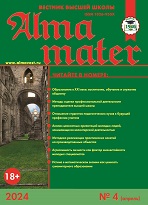UDC 373-042.1
https://doi.org/10.20339/AM.12-20.022
N.A. Spirina Natalya is Cand.Sci. (Economics), Ass. Prof. e-mail: natalya.spirins@ui.ranepa.ru; and S.A. Makovkina is Senior Lecturer e-mail: svetlana.makovkina@ui.ranepa.ru, both at Ural Institute of Management — branch of RANEPA, Ekaterinburg
Researched is the problem of new methods of vocational guidance of schoolchildren, because traditional forms lose their effectiveness and relevance. Such new method, as gamification, might ensure maximum involvement of participants in vocational guidance process, allow to “test” a particular profession in game created reality, and that will help to choose future career soundly. The purpose of this study is to justify relevance of incorporating gamification technology into career counseling activities and to develop practical recommendations on the use of live-action games to form psychological readiness of schoolchildren for professional self-determination. The use of gaming technologies and mechanic will allow the student to be immersed in created alternative reality, in what he gets the opportunity to feel like a specialist performing real labor function that gives a clear understanding of a certain professional activity. The authors substantiate the main advantages of gamification in career-oriented work, such as involvement, motivation, replayability and development of meta-subject skills (soft skills). The article offers three basic scenarios of live action games, as a career guidance activities for high school students, developed on the basis of the authorities’ specifics. The authors substantiate effectiveness of application of innovative methods in vocational guidance of schoolchildren. The scenarios proposed by the authors might be used for any professional activity, lend themselves to adaptation and modification, and not only increase effectiveness of career guidance measures due to the high degree of involvement of participants, but also develop meta-subject skills of senior classes’ schoolchildren.
Key words: career guidance, gamification, live action game, professional self-determination.
References
1. Putin declared the need for early career guidance. RIA Novosti = RIA News [Internet]. URL: https://ria.ru/20191126/1561611955.html (In Russ.) (accessed on 10.04.2020).
2. Gusenko, M. I’ll go there, I don’t know where. Rossiyskaya gazeta = Russian newspaper. 2019. No. 111 (7869). (In Russ.)
3. ONF poll: 29% of students do not understand what to do in the future. Youngspace — youth magazine. URL: https://youngspace.ru/novosti/opros-onf-29-shkolnikov-ne-ponimayut-chem-... (In Russ.) (accessed on 11.04.2020).
4. Gimelshein, E., Godvan, D. Gamification in vocational guidance for students. Business education in the knowledge economy. 2020. No. 1(15). Р. 12–14 (In Russ.).
5. Reiners, T., Wood, L.C. Gamification in education and business. New York: Springer. 2015. P. 697.
6. Marczewski, A. Gamification: a simple introduction. New York, 2013. 288 p.
7. Khramkin, P. Gamify it: how to turn a lesson into a game. ISpring Online Learning. URL: https://www.ispring.ru/ elearning-insights/gameschool (accessed on 10.04.2020). (In Russ.).
8. Chelugin, V. Methods of teaching a foreign language. St. Petersburg: Aspekt-Press; 2014. 490 p. (In Russ.).
9. Pyadina, T., Careva, I. Gamification of student learning. Theory. Practice. Innovation, a series of public education. Pedagogy. 2017, December 116–120 (In Russ.).
10. Bannyh, G. Gamification in University Education: A Comparative Analysis of Practices. In: Strategies for the development of social communities, institutions and territories: proceedings of the III International Scientific and Practical Conference, 2017 21–22 April, Part 1. Ekaterinburg; 2017. Р. 277–280 (In Russ.).
11. Belkin, F. Gamification in education. Modern foreign psychology. 2016. Part 5. No. 3. P. 28–34. URL: https://psyjournals.ru/files/83892/jmfp_2016_n_3_Belkin.pdf (accessed on 12.04.2020). (In Russ.).
12. Karpenko, O., Luk’yanova, A., Abramova, A., Basov V. Gamification in e-learning. Distance and virtual learning. 2015. No. 4. Р. 28–43. (In Russ.).
13. Gimel’shtejn, E., Godvan, D. Gamification in vocational guidance for students. Business education in the knowledge economy. 2020. 1. 12–15. (In Russ.).
14. Dmitrieva, T., Tokarev, M. Gamification as one of the methods of career guidance in additional education of children. In: Collection of selected articles on the materials of scientific conferences of the Humanitarian Research Institute “National Development”, 2019; Publisher: Private Scientific and Educational Institution of Continuing Professional Education Humanitarian National Research Institute “National Development”, St. Petersburg., 2019 P. 168–169. (In Russ.)
15. Savvina, A., The method of gamification in vocational guidance of students (on the example of “Atlas of new professions”. In: Innovations and traditions of pedagogical science — 2018. Proceedings of the XVIII International Scientific and Practical Conference, 2018; Publisher: Interregional Center for Innovative Technologies in Education, Kirov, 2018. P. 482–485. (In Russ.).
16. Zalevskaya, V. The formation of social competence of primary school students in the process of career-oriented game. Pedagogical issues. 2019. No. 2. Р. 92–96. (In Russ.)
17. Zikermann, G., Linder, J. Gamification in business: how to break through the noise and capture the attention of employees and customers. Мoscow: Publishing house Mann, Ivanov and Ferber, 2011. 272 p. (In Russ.).
18. Kaufmann, L. Dyscalculia from a developmental and differential perspective. Frontiers in Psychology. 2013, Vol. 4. Article 516. Р. 168–171.
19. Yildirim I. The effects of gamification-based teaching practices on student achievement and students’ attitudes toward lessons. Internet and Higher Education. 1 April 2017. Vol. 33. P. 86–92.











.png)






